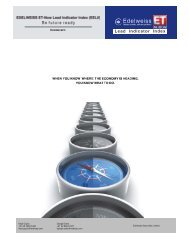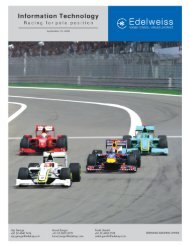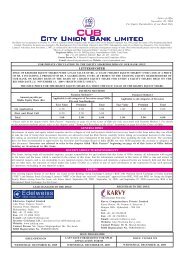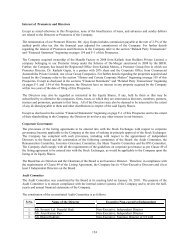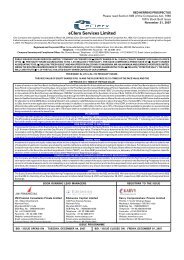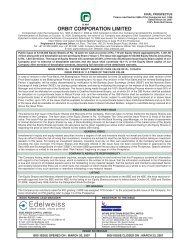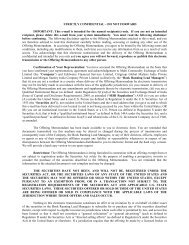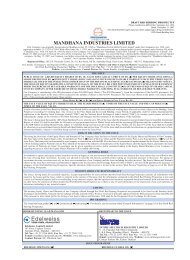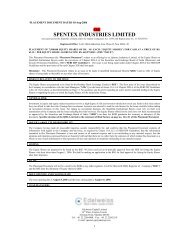Edelweiss Style Analysis
Edelweiss Style Analysis
Edelweiss Style Analysis
Create successful ePaper yourself
Turn your PDF publications into a flip-book with our unique Google optimized e-Paper software.
<strong>Edelweiss</strong> <strong>Style</strong> <strong>Analysis</strong><br />
What‘s hot...<br />
March 2009<br />
<strong>Edelweiss</strong> <strong>Style</strong> <strong>Analysis</strong><br />
Yogesh Radke<br />
+91 22 6620 3199<br />
yogesh.radke@edelcap.com<br />
Mehul Patel<br />
+91 22 4063 5556<br />
mehul.patel@edelcap.com<br />
<strong>Edelweiss</strong> Securities Limited<br />
1
<strong>Edelweiss</strong> <strong>Style</strong> <strong>Analysis</strong><br />
CONTENTS<br />
What’s Hot ....................................................................................................................... 2<br />
ESA (<strong>Edelweiss</strong> style analysis)<br />
Introduction ...................................................................................................................... 3<br />
Factor model<br />
<strong>Style</strong> <strong>Analysis</strong><br />
Various factor<br />
Why Multi Factor Model………………… ....................................................................................... 4<br />
<strong>Edelweiss</strong> <strong>Style</strong> <strong>Analysis</strong> ..................................................................................................... 5<br />
Various Factor Groups ........................................................................................................ 6<br />
Momentum factor<br />
Growth factor<br />
Value factor<br />
Quality factor<br />
Conclusion .......................................................................................................................10<br />
Market Snapshot ..............................................................................................................11<br />
<strong>Edelweiss</strong> Multi Factor Models .............................................................................................12<br />
Back-Test Results .............................................................................................................13<br />
<strong>Edelweiss</strong> style analysis factor model<br />
Appendix:........................................................................................................................16<br />
Assumptions ....................................................................................................................18<br />
<strong>Edelweiss</strong> Securities Limited<br />
2
<strong>Edelweiss</strong> <strong>Style</strong> <strong>Analysis</strong><br />
What’s Hot<br />
<strong>Edelweiss</strong> style analysis portfolio- ESA<br />
Under prevailing market conditions, ESA factor model indicates EV to Fixed Assets, 6-month<br />
price momentum and Cash flow growth are three Street favorite factors for stock picking for<br />
March 2009.<br />
We recommend equal weighted value neutral portfolio.<br />
Current month portfolio<br />
Portfolio for March 2009<br />
Top 10 Long-portfolio stocks<br />
Company Name<br />
A C C<br />
G A I L (India)<br />
N T P C<br />
India Cements<br />
Tata Power Co.<br />
Grasim Industries<br />
Hero Honda Motors<br />
Bharti Airtel<br />
I T C<br />
Bharat Petroleum Corpn.<br />
Bottom 10 Short-portfolio stocks<br />
Company Name<br />
Mahindra & Mahindra<br />
Tata Consultancy Services<br />
Bharat Heavy Electricals<br />
Tata Chemicals<br />
Larsen & Toubro<br />
Reliance Infrastructure<br />
Divi'S Laboratories<br />
Wipro<br />
A B B<br />
Suzlon Energy<br />
Source: <strong>Edelweiss</strong> research<br />
Performance for the last month: Long only = (0.6%), NIFTY = (1.4%), Short only= 8.0%,<br />
Long-Short NIFTY = 0.8%, Long-Short stocks = 7.4%<br />
Previous month ESA portfolio was based on 12-month price momentum, 6-month price<br />
momentum and 3-month price momentum.<br />
Previous month portfolio<br />
Portfolio for February 2009<br />
Top 10 Long-Portfolio stocks<br />
Company Name<br />
% Return<br />
Hindustan Petroleum Corpn. (0.3)<br />
Bharat Petroleum Corpn. (0.9)<br />
N T P C (2.9)<br />
Hero Honda Motors 4.8<br />
Indian Oil Corpn. 0.8<br />
Hindustan Unilever (1.3)<br />
Power Grid Corpn. Of India 2.7<br />
Cairn India 1.1<br />
Tata Communications (11.1)<br />
Cipla 0.8<br />
Total average return (0.6)<br />
Bottom 10 Short-Portfolio stocks<br />
Company Name<br />
% Return<br />
Reliance Communications 1.8<br />
Siemens (13.1)<br />
Suzlon Energy 8.6<br />
Bharat Forge (3.7)<br />
J S W Steel 11.0<br />
D L F 4.8<br />
Punj Lloyd 11.6<br />
Welspun-Gujarat Stahl Rohren 15.9<br />
Housing Development & Infrastructure 19.2<br />
Aban Offshore 23.4<br />
Total average return 8.0<br />
Source: <strong>Edelweiss</strong> research<br />
<strong>Edelweiss</strong> Securities Limited<br />
3
<strong>Edelweiss</strong> <strong>Style</strong> <strong>Analysis</strong><br />
Introduction<br />
Factor model<br />
Over the past few years, Indian capital markets have taken giant strides to enter the league<br />
of global profitable investment avenues. This growth has attracted investors with diverse<br />
investment strategies in quest for better returns. Along with this bustling growth, investment<br />
strategies too are undergoing a paradigm shift. The conventional long only strategies are<br />
gradually being sidelined by quantitative models with emphasis on long-short portfolios. Such<br />
a drift is justified on the back of volatile nature of equity markets globally.<br />
The <strong>Edelweiss</strong> <strong>Style</strong> <strong>Analysis</strong> (ESA) gives you cutting-edge research and an in-depth analysis<br />
on ‘what’s hot’ in the current scenario. The analysis revolves round various factors driving the<br />
market in different scenarios and tries to capture factors driving the current momentum. We<br />
believe that markets follow a typical investment style or pattern at different intervals, which<br />
is mirrored by certain factors. The analysis provides investors with an understanding of the<br />
factors that are currently working in prevailing market conditions to enhance portfolio<br />
performance. The analysis outlines a host of long–short portfolios drawn on the basis of these<br />
factors.<br />
The efficacy of the Factor Model is gauged by the performance of portfolios from various<br />
dimensions:<br />
• Long Portfolio<br />
• Short Portfolio<br />
• Long–Short Portfolio<br />
• Long–Short Nifty<br />
• Nifty<br />
<strong>Style</strong> analysis<br />
<strong>Style</strong> analysis is basically a framework for measuring the efficacy of a select set of<br />
fundamental and technical factors blended with certain quantitative disciplines. It tries to<br />
encapsulate traditional investment styles of value and growth buying. <strong>Style</strong> analysis aims to<br />
capture the factor momentum under prevailing market conditions to maximize the magnitude<br />
and stability of expected incremental performance. However, due to changing market<br />
dynamics, factors are bound to change from time to time. A specific factor riding the<br />
momentum may change over a period of time.<br />
Various factors<br />
<strong>Style</strong> analysis makes use of a host of factors that aid momentum in a specific stock. P/E, EPS,<br />
revenue, book value, EBITDA, enterprise value, P/BV, RoE, are a few factors used for this<br />
analysis. The above given factors often serve as an efficient evaluation tool. For simplicity<br />
and better understanding, the factors are placed into different baskets as follows:<br />
• Momentum Factors<br />
• Growth Factors<br />
• Value Factors<br />
• Quality Factors<br />
<strong>Edelweiss</strong> Securities Limited<br />
4
<strong>Edelweiss</strong> <strong>Style</strong> <strong>Analysis</strong><br />
Why Multi Factor Model<br />
<strong>Edelweiss</strong> multi factor model aims to diagnose right factor momentum to out perform the<br />
benchmark by earning the alpha gains. Active investors like hedge funds, institutions, and<br />
portfolio managers have been known to effectively profit from similar strategies. Considering<br />
the volatility in equity markets, such an alternative investment can be effective in diversifying<br />
the allocations and maximizing returns. Investment styles may be long portfolio, long<br />
portfolio–short Nifty, or long–short portfolio.<br />
Market in a bull run may augur well for a long portfolio style of investment, while in an<br />
unstable market a long portfolio and short Nifty would be the preferred investment strategy.<br />
In case of an uncertain market with negative bias, the long–short portfolio style of<br />
investment is preferable. These strategies seem to be generating good returns on a<br />
consistent basis and thus can be a preferred one during volatility where negative cues clearly<br />
seem to outplay positive ones.<br />
<strong>Edelweiss</strong> Securities Limited<br />
5
<strong>Edelweiss</strong> <strong>Style</strong> <strong>Analysis</strong><br />
<strong>Edelweiss</strong> <strong>Style</strong> <strong>Analysis</strong> (ESA)<br />
Introduction<br />
Under dynamic market conditions, generation of Alpha returns is often the greatest challenge<br />
confronting fund managers, which has underscored the increased importance of quantitative<br />
stock picking. At the same time, for an active portfolio manager, a detailed understanding of<br />
factor styles under changing market regimes is becoming increasingly important. Through<br />
this research, we analyze the efficacy of fundamental and technical factors for stock selection<br />
to complement the skill set of a portfolio manager.<br />
Model description<br />
The ability to predict the relative performance of various styles and successfully<br />
implementing a strategy based on these predictions should have a positive effect on overall<br />
investment returns. Indeed, as we have seen in our monitoring of investment performance<br />
based on these styles over the years, being in appropriate groups (e.g., value, growth,<br />
market cap) can make an enormous difference to investment success. This study examines<br />
the efficacy of over 20 superior factors and back-test the each factor portfolio returns since<br />
January 2003.<br />
Single factor portfolio construction methodology: To construct long-short factor<br />
portfolios, we rank stocks within the coverage universe by each factor every month, and<br />
group them into five quintiles (quintile 1 contains the highest ranked stocks). For each factor,<br />
we then calculate the one month subsequent performance of these five equally weighted<br />
quintile portfolios, and compute the performance difference between the highest and lowest<br />
quintiles (Q1–Q5), to arrive at a factor return.<br />
Factor groups: Over 20 factors derived from fundamental and technical data base were<br />
grouped into four categories—growth, momentum, value, and quality factors. (Explained in<br />
detail later).<br />
Back-test results for each static factor portfolio: We report the cumulative return of<br />
portfolios based on single factor since January 2003.<br />
<strong>Edelweiss</strong> Securities Limited<br />
6
<strong>Edelweiss</strong> <strong>Style</strong> <strong>Analysis</strong><br />
Various Factor Groups<br />
Momentum factor<br />
Momentum investing has taken the Indian stock market by a storm over the past couple of<br />
years. The essence of this stock strategy is to buy winners and sell losers. Within the<br />
momentum factor, it is worth noting that the duration of past performance (12-month/6-<br />
months/3months) will influence the type of strategy that should be employed.<br />
Longer look back and optimal holding period produce more reliable returns that are<br />
sustainable over the long term. In this study, a 12-month and 6-month look back and a onemonth<br />
holding period appear to be optimal. This is consistent with our intuition that investors<br />
under react to information over the medium term (3 months), thus justifying the 12-month<br />
look back as optimal. Momentum factors have shown greater dependence on market regime<br />
change on time to time basis.<br />
The graph below shows cumulative returns of single factor portfolio with the base of 100 in<br />
January 2003.<br />
Momentum factor (Top-bottom Quintile returns %)<br />
(Cumulative factor returns)<br />
600<br />
500<br />
400<br />
300<br />
200<br />
100<br />
0<br />
Feb-03<br />
May-03<br />
Aug-03<br />
Nov-03<br />
Feb-04<br />
May-04<br />
Aug-04<br />
Nov-04<br />
Feb-05<br />
May-05<br />
Aug-05<br />
Nov-05<br />
Feb-06<br />
May-06<br />
Aug-06<br />
Nov-06<br />
Feb-07<br />
May-07<br />
Aug-07<br />
Nov-07<br />
Feb-08<br />
May-08<br />
Aug-08<br />
Nov-08<br />
12 Month Price Momentum 6 Month Price Momentum<br />
3 Month Price Momentum<br />
Feb-09<br />
Source: <strong>Edelweiss</strong> research<br />
<strong>Edelweiss</strong> Securities Limited<br />
7
<strong>Edelweiss</strong> <strong>Style</strong> <strong>Analysis</strong><br />
Growth factor<br />
Growth style typically focuses on a company’s historical earnings growth to identify stocks<br />
with the prospect of growing earnings at above-average rates versus the market. Managers<br />
seek to invest in stocks of companies whose future earnings power has been underestimated<br />
by markets. Growth is generally associated with greater upside potential, albeit with greater<br />
risk on the downside.<br />
From the growth factor chart below it is evident that none of the growth factors have given<br />
incremental returns considering the fact that much of the weight has been given to price<br />
momentum-driven factors all through out the bull market period.<br />
Since June 2007, BVPS* growth has shown positive momentum, at the same time, EBITDA<br />
growth has remained volatile, where as sales growth has continuously given negative returns<br />
all through out the sample period.<br />
Growth factor (Top-bottom Quintile returns %)<br />
(Cumulative factor returns)<br />
190<br />
160<br />
130<br />
100<br />
70<br />
40<br />
Feb-03<br />
May-03<br />
Aug-03<br />
Nov-03<br />
Feb-04<br />
May-04<br />
Aug-04<br />
Nov-04<br />
Feb-05<br />
May-05<br />
Aug-05<br />
Nov-05<br />
Feb-06<br />
May-06<br />
Aug-06<br />
Nov-06<br />
Feb-07<br />
May-07<br />
Aug-07<br />
Nov-07<br />
Feb-08<br />
May-08<br />
Aug-08<br />
Nov-08<br />
Feb-09<br />
1 Year EPS Growth 1 Year Sales Growth 1 Year DPS Growth<br />
1 Year CFPS Growth 1 Year BVPS Growth 1 Year EBITDA Growth<br />
Source: <strong>Edelweiss</strong> research * Please refer appendix on page no 16.<br />
<strong>Edelweiss</strong> Securities Limited<br />
8
<strong>Edelweiss</strong> <strong>Style</strong> <strong>Analysis</strong><br />
Value factor<br />
The value factor style of investing has exhibited cyclical behavior over time, but predicting<br />
inflection points in these cycles has been a challenge for investors.<br />
Value factors typically focus on existing assets and valuation measures that equate a stock’s<br />
price to the company’s intrinsic value. The premise for value managers is that the market has<br />
incorrectly priced a stock in relation to the firm’s current assets and earnings and the<br />
company will be revalued over time, thereby to generate value for investors. Value is<br />
traditionally associated with more moderate upside and greater downside protection over<br />
market cycles than growth.<br />
Looking at the value factor chart, market cap to sales and price to cash flow are two leading<br />
factors which have performed consistently whereas price to earnings is favored in recent<br />
market turmoil, on the other side EV/EBITDA is the worst performer in the value factor pack<br />
all throughout the sample period.<br />
The value factor pack has shown varied patterns under changing market conditions. Till mid-<br />
2005 a couple of value factors were effective and had given incremental returns, but in the<br />
later bull market, they have lost momentum and got penalized..<br />
Value factor (Top-bottom Quintile returns %)<br />
(Cumulative factor returns)<br />
240<br />
200<br />
160<br />
120<br />
80<br />
40<br />
`<br />
Feb-03<br />
May-03<br />
Aug-03<br />
Nov-03<br />
Feb-04<br />
May-04<br />
Aug-04<br />
Nov-04<br />
Feb-05<br />
May-05<br />
Aug-05<br />
Nov-05<br />
Feb-06<br />
May-06<br />
Aug-06<br />
Nov-06<br />
Feb-07<br />
May-07<br />
Aug-07<br />
Nov-07<br />
Feb-08<br />
May-08<br />
Aug-08<br />
Nov-08<br />
Feb-09<br />
Price to Earnings Market Cap to Sales Price to Dividend<br />
Price to Cashflow Price to Book value EV/FA<br />
EV/EBITDA<br />
Source: <strong>Edelweiss</strong> research<br />
<strong>Edelweiss</strong> Securities Limited<br />
9
<strong>Edelweiss</strong> <strong>Style</strong> <strong>Analysis</strong><br />
Quality factor<br />
Besides the above conventional style factors, there are a couple of quality factors which have<br />
shown a linear relationship with stock movement under different market conditions.<br />
From the quality factor chart below it is evident that market cap (size) factor performance<br />
during a market downturn was considerably higher than in other periods, indicating that at<br />
every fall, large cap stocks are favored against small caps.<br />
12-month price momentum/Beta is highly correlated to 12-month price momentum factor,<br />
indicating that stocks with high return high Beta share the same characteristics as price<br />
momentum factor in a bull market.<br />
As witnessed globally during a bull market run, RoE does not play a significant role in<br />
explaining the returns. Market players have ignored RoE throughout the bull run and as a<br />
result it has remained flat with upward bias every time the market falls.<br />
Quality factor (Top-bottom Quintile returns %)<br />
360<br />
(Cumulative factor returns)<br />
300<br />
240<br />
180<br />
120<br />
60<br />
`<br />
0<br />
Feb-03<br />
May-03<br />
Aug-03<br />
Nov-03<br />
Feb-04<br />
May-04<br />
Aug-04<br />
Nov-04<br />
Feb-05<br />
May-05<br />
Aug-05<br />
Nov-05<br />
Feb-06<br />
May-06<br />
Aug-06<br />
Nov-06<br />
Feb-07<br />
May-07<br />
Aug-07<br />
Nov-07<br />
Feb-08<br />
May-08<br />
Aug-08<br />
Nov-08<br />
Feb-09<br />
ROE 12 Month Price Momentum / Beta Size<br />
Source: <strong>Edelweiss</strong> research<br />
<strong>Edelweiss</strong> Securities Limited<br />
10
<strong>Edelweiss</strong> <strong>Style</strong> <strong>Analysis</strong><br />
Conclusion<br />
In isolation, none of the factors outperform the broader index on consistent basis. Single<br />
factor effectiveness can vary over time, depending on the prevailing market regime and no<br />
single factor works consistently for every market condition. Fund managers can mitigate<br />
challenges of timing style & sub-style cycles by engaging in active style management.<br />
Discerning inflection points of style & sub-style cycles is difficult. Employing a more robust<br />
mechanism to capture the prevailing style may help capture more returns.<br />
Assessment of various styles & sub-style is necessary to better understand the implications of<br />
equity allocations regardless of cycles, while increasing diversification.<br />
Various permutations of styles can be explored to optimize the diversification and return<br />
objectives of fund managers. Given the unpredictable nature and recent magnitude of style<br />
cycles, fund mangers may be better served by choosing multiple investments within a substyle<br />
category where characteristics and behavior together are complementary.<br />
<strong>Edelweiss</strong> Securities Limited<br />
11
<strong>Edelweiss</strong> <strong>Style</strong> <strong>Analysis</strong><br />
Market snapshot<br />
In February 2009, 12-month price momentum, 6-month price momentum and Size have<br />
worked well; indicating continued risk averse approached by investors where as growth<br />
stocks have continued downward trend amid growing future growth concerns.<br />
Top-bottom Quintile returns %<br />
(50) (40) (30) (20) (10) - 10 20 30 40 50<br />
* Benchmark = NIFTY (for illustration only)<br />
Last 6 Month Last 3 Month Last Month<br />
Source: <strong>Edelweiss</strong> research<br />
Note: (1) All factor performance (for past six months: September 2008 to February 2009)<br />
(2) Sorted on the descending order of previous month’s top performing factor<br />
<strong>Edelweiss</strong> Securities Limited<br />
12
<strong>Edelweiss</strong> <strong>Style</strong> <strong>Analysis</strong><br />
<strong>Edelweiss</strong> Multi Factor Model<br />
The multi factor model aims to catch the style momentum under prevailing market conditions<br />
to maximize the magnitude and stability of expected incremental performance. We have<br />
presented a robust mechanism for exploiting market anomalies via quantitative multi-factor<br />
stock selection model. The approach aims to extract independent sources of alpha under<br />
prevailing market regimes. By performing out-of-sample back-tests, we can exploit alpha<br />
opportunities for long only and long-short (benchmark and stocks) portfolios. Our research<br />
continues to make a strong case for this type of style-driven approach, complementing<br />
valuation-based active stock picking strategies and empowering a more holistic approach to<br />
the investment process.<br />
To catch the factor momentum we have applied the information coefficient (IC) to decide the<br />
relative importance of the factors in a given month. IC entails to depict how well a factor is<br />
correlated with (subsequent) returns. It is the correlation coefficient between the factor rank<br />
and the return rank for all companies in the universe for a specific period.<br />
The Alternative and Derivative Research team at <strong>Edelweiss</strong> has implemented the Quantitative<br />
Stock Selection Model, and will provide monthly stock signals (long only and long-short) and<br />
style shift analysis reports.<br />
Methodology<br />
Diagnosing the top three factors with high IC and significant level of IC T-stats on monthly<br />
basis and complementing the same with factor’s top-bottom quintile performance (as<br />
discussed above).<br />
The multi-factor rank equal weighted portfolio are constructed applying top three factors with<br />
high IC.<br />
<strong>Edelweiss</strong> Securities Limited<br />
13
<strong>Edelweiss</strong> <strong>Style</strong> <strong>Analysis</strong><br />
Back-Test Results<br />
<strong>Edelweiss</strong> style analysis factor model (ESA factor model):<br />
We back-tested the style analysis on BSE-100 Universe for last nine years (Since 2000) and<br />
as expected results looks promising considering the hypothesis is applied on smaller universe<br />
of approximately 80 stocks ( excluding financials ).<br />
Further to this, sincere effort has been made to back-test hypothesis for 2000-2002 bear<br />
market phase and results are consistent with later bull market period to ensure that results<br />
are not excessively influenced by recent Bull Run.<br />
Please note hypothesis has been back-tested using the same factors applied in earlier ESA<br />
factor model except 12-months momentum to Beta whereas PEG ratio has been included in<br />
back-test from Jan-2003 onwards.<br />
ESA factor model versus benchmark observation<br />
Long only and long-short (stock) rupee neutral portfolios have outpaced the benchmark<br />
consistently, whereas the short portfolio has been consistently lagging the benchmark. As a<br />
result, long-short (stock) spread is widening on a continuous basis, signifying EESA factor<br />
model effectiveness.<br />
Whereas long-short (NIFTY) rupee neutral portfolio has generated the similar returns as<br />
compared to the benchmark with lesser volatility and high risk reward ratio (information<br />
ratio).<br />
The equity curve shows cumulative returns of a portfolio with a base of 100 since January<br />
2000.<br />
<strong>Edelweiss</strong> Securities Limited<br />
14
<strong>Edelweiss</strong> <strong>Style</strong> <strong>Analysis</strong><br />
ESA factor model cumulative % return<br />
2,500<br />
2,000<br />
1,500<br />
1,000<br />
500<br />
0<br />
Long Portfolio - Short Portfolio<br />
Long Portfolio - Short NIFTY<br />
NIFTY<br />
Short Portfolio<br />
Long Portfolio<br />
Source: <strong>Edelweiss</strong> research<br />
ESA factor model versus benchmark results<br />
Long only and long-short (stocks) rupee neutral portfolios have outpaced the benchmark<br />
consistently & has given average returns of 43% and 36% p.a. respectively Vs. NIFTY returns<br />
of 15% p.a.<br />
The long portfolio, long stocks-short NIFTY and long–short stocks portfolio has maintained<br />
the 89%,100% & 100% hit ratio respectively on Y-o-Y basis, where as 66%, 55%, and 62%<br />
respectively, M-o-M basis.<br />
So, combining the observations, we can summarize that the long only portfolio stocks have<br />
been able to beat the index fairly consistently and long-short (benchmark & stocks) rupee<br />
neutral portfolios have consistently generated the Alpha and have been able to provide<br />
significantly better returns with acceptable annualized information ratio of 0.7,1.1, and 1.3<br />
respectively Vs. NIFTY information ratio of 0.4.<br />
ESA factor model annualized performance (Y-o-Y)<br />
200.0<br />
(Return per year %)<br />
150.0<br />
100.0<br />
50.0<br />
0.0<br />
(50.0)<br />
(100.0)<br />
2000 2001 2002 2003 2004 2005 2006 2007 2008 2009-<br />
Long Portfolio<br />
NIFTY<br />
YTD<br />
Long Portfolio - Short NIFTY<br />
Short Portfolio<br />
Long Portfolio - Short Portfolio<br />
Source: <strong>Edelweiss</strong> research<br />
<strong>Edelweiss</strong> Securities Limited<br />
15
<strong>Edelweiss</strong> <strong>Style</strong> <strong>Analysis</strong><br />
ESA Annual return matrix (%)<br />
Annual return matrix (%)*<br />
Period Long portfolio NIFTY<br />
Long portfolio -<br />
Short NIFTY Short portfolio<br />
Long portfolio - Short<br />
portfolio<br />
Jan00-Dec-00 1.5 (8.6) 10.5 57.8 64.3<br />
Jan01-Dec-01 5.1 (7.8) 17.7 (9.4) 13.9<br />
Jan02-Dec-02 41.0 4.2 32.7 (11.2) 29.1<br />
Jan03-Dec-03 161.4 72.7 54.6 (37.1) 75.3<br />
Jan04-Dec-04 32.1 5.3 24.6 (14.1) 18.2<br />
Jan05-Dec-05 31.6 31.5 0.7 (23.7) 8.3<br />
Jan06-Dec-06 44.4 36.3 4.8 (21.4) 18.2<br />
Jan07-Dec-07 116.5 55.3 43.9 (22.8) 73.6<br />
Jan08-Dec-08 (49.3) (52.5) 2.7 88.2 19.2<br />
Jan09-Dec-09* (6.9) (4.6) (2.3) 10.7 3.3<br />
Average return 42.7 15.2 21.4 0.7 35.6<br />
Standard deviation 62.6 37.9 19.1 42.5 27.3<br />
Information ratio (Times) 0.7 0.4 1.1 0.0 1.3<br />
Source: <strong>Edelweiss</strong> research<br />
Note: * Returns are calculated on cumulative basis.<br />
ESA Monthly return matrix (%)<br />
Monthly return matrix (%)<br />
Long portfolio NIFTY<br />
Long portfolio -<br />
Short NIFTY Short portfolio<br />
Long portfolio - Short<br />
portfolio<br />
Average 2.7 1.0 1.7 0.1 2.8<br />
Best 41.8 15.7 34.4 43.4 38.5<br />
Worst (24.5) (34.4) (11.1) (35.8) (28.1)<br />
Standard deviation 10.6 8.0 6.5 10.2 9.1<br />
Hit ratio 66% 59% 55% 46% 62%<br />
Source: <strong>Edelweiss</strong> research<br />
12-month rolling ESA monthly return matrix (%)<br />
Monthly return matrix (%)<br />
Period Long portfolio NIFTY<br />
Long portfolio -<br />
Short NIFTY Short portfolio<br />
Long portfolio - Short<br />
portfolio<br />
Feb-08 5.2 (1.8) 7.0 3.6 8.7<br />
Mar-08 (9.3) (9.4) 0.1 14.4 5.1<br />
Apr-08 9.5 9.1 0.4 (10.8) (1.3)<br />
May-08 0.3 (5.7) 6.0 7.5 7.9<br />
Jun-08 (13.2) (17.0) 3.8 18.2 5.0<br />
Jul-08 8.2 7.2 0.9 (13.3) (5.2)<br />
Aug-08 0.0 0.6 (0.6) (3.6) (3.6)<br />
Sep-08 (10.9) (5.7) (5.2) 12.8 1.9<br />
Oct-08 (24.1) (34.4) 10.2 43.4 19.3<br />
Nov-08 (0.3) 2.2 (2.5) 5.4 5.1<br />
Dec-08 1.4 5.9 (4.5) (19.3) (17.9)<br />
Jan-09 (6.3) (3.2) (3.1) 2.5 (3.8)<br />
Feb-09 (0.60) (1.40) 0.80 8.00 7.40<br />
<strong>Edelweiss</strong> Securities Limited<br />
16
<strong>Edelweiss</strong> <strong>Style</strong> <strong>Analysis</strong><br />
APPENDIX<br />
Factor definitions<br />
Momentum factors<br />
12 month / 6 months / 3 months price performance: Indicates acceleration /<br />
deceleration in a stock’s price performance. High reading is preferred.<br />
Growth factors<br />
Earning per share (EPS) growth: Represents trailing 12-month EPS growth over the past<br />
two corresponding years.<br />
Sales growth: Represents trailing 12-month sales growth over the past two corresponding<br />
years.<br />
Dividend per share (DPS) growth: Growth in DPS indicates high earnings growth and/or<br />
rising payout ratio over the past two reporting periods.<br />
Operating cash flow per share (OCFPS) growth: Indicates high depreciation and/or high<br />
net income and/or efficient working capital management over the past two reporting periods.<br />
Book value per share (BVPS) growth: Book value represents the equity of the firm.<br />
Growth in book value indicates and/or of high earnings growth and/or low payout ratio and/or<br />
lesser conversion of convertibles or a low rights issue and/or equity issuance at greater than<br />
bps.<br />
EBITDA growth: Represents trailing 12-month EBITDA growth over the past two<br />
corresponding years. Growth in EBITDA indicates high topline growth flowing down to the<br />
EBITDA line or EBITDA margin expansion, i.e., good operational performance.<br />
Value factors<br />
Enterprise value ( EV ) to EBITDA: The ratio is meant to give a proxy for value of net<br />
debt and equity divided by EBITDA. A low reading is an indication of good value for debt and<br />
equity holder but can also indicates low EBITDA growth prospects.<br />
Price to book: A low ratio indicates good value, but can also be an indication of lackluster<br />
growth and/or profitability prospects.<br />
Price to earnings: A low ratio indicates good value but can also be an indication of<br />
lackluster growth prospects. The ratio is widely used due to its simplicity.<br />
Price to sales: A low ratio indicates good value but can also be an indication of lackluster<br />
growth prospects and/or low margins currently or in the future.<br />
Price to DPS: A low ratio indicates high earnings growth and/or rising payout ratio, but can<br />
also indicate lackluster growth prospects.<br />
Price to operating cash flow per share (OCFPS): A low ratio indicates efficient working<br />
capital management and/or high depreciation and/or high net income.<br />
Enterprise value (EV) to fixed assets (FA): The ratio is meant to give a proxy for value of<br />
net debt and equity divided by fixed assets available to debt and equity holders. A low<br />
reading is an indication of good value for debt and equity holding but can also indicate lower<br />
fixed assets efficiency level.<br />
<strong>Edelweiss</strong> Securities Limited<br />
17
<strong>Edelweiss</strong> <strong>Style</strong> <strong>Analysis</strong><br />
Quality factors<br />
Return on equity (ROE): Defined as net income divided by common equity. A high ratio<br />
indicates good operational performance and/or financial efficiency, and a high return to<br />
equity shareholder. It also reflect ability to utilise assets effeciently to generate earnings.<br />
Size: Indicates market capitalization of a company. Market capitalization is calculated by<br />
multiplying a company’s shares outstanding by the current market price.<br />
12-month performance/Beta: A high value implies that the stock has performed better<br />
than would have been expected given its beta level, therefore favourable reward/risk profile.<br />
Price earnings to growth (PEG): PEG is a widely used indicator of a stock’s potential value.<br />
It is favored by many over the price/earnings ratio because it also accounts for<br />
growth. Similar to the P/E ratio, a lower PEG means that the stock is more undervalued.<br />
Information coefficient<br />
The information coefficient (IC) is a concise measure of how well a factor is correlated with<br />
(subsequent) returns. It is the correlation coefficient between the factor rank and the return<br />
rank for all companies in the universe for a specific period.<br />
Information coefficient is calculated as:<br />
In order to calculate the significance of IC we have applied<br />
IC T-Stat = sqrt [(n-2)/ (1-r × r)] × r<br />
Where<br />
n = # companies in the universe<br />
r = the correlation coefficient between the two arrays (the IC)<br />
<strong>Edelweiss</strong> Securities Limited<br />
18
<strong>Edelweiss</strong> <strong>Style</strong> <strong>Analysis</strong><br />
Assumptions<br />
(I)<br />
Universe<br />
ESA factor model: Strategy has been back-tested using BSE-100 universe.<br />
Financial stocks have been excluded since many factors would have no clear meaning.<br />
Companies with less than two year of financial history and one year trading history<br />
have been excluded.<br />
(II)<br />
We consistently look at total returns: Many market participants look solely at<br />
prices. But, it is important for investors to be aware of the total returns available from<br />
stocks, in the form of capital gains (via price) and income (via dividends). Quite a lot<br />
of factor effectiveness research looks solely at price returns, but we consistently use<br />
total returns in our research.<br />
(III) Our database has been carefully developed to minimize look-forward bias:<br />
Many researchers use databases which make simple or even simplistic assumptions<br />
about when new information became available. Frequently, this means that their “outof-sample”<br />
results are actually contaminated by information that would not have been<br />
available at the time. Obviously, investors should be skeptical about the results from<br />
such work. We believe our database does not suffer from this problem.<br />
(1V) What’s hot: This approach is suitable for stock picking within a defined universe,<br />
where stocks have sufficient dispersion both in factors and in returns. If all stocks in a<br />
particular market tend to move up and down together, then obviously a factor-based<br />
approach will generally be less effective, because there will be less opportunity to use<br />
factor effectiveness to distinguish between the best and worst performers.<br />
(V)<br />
It is important to note that long-short portfolio returns do not account for<br />
transaction costs including the bid-ask spread and the market impact of buying and<br />
selling.<br />
(VI) Hit ratio: signifies number of month’s portfolio has given positive returns out of total<br />
sample period.<br />
(VII) Portfolio neutrality: Long-short (stocks or NIFTY) portfolio has been constructed and<br />
back-tested keeping in mind least possible sector exposure at any given point of time.).<br />
<strong>Edelweiss</strong> Securities Limited<br />
19
<strong>Edelweiss</strong> <strong>Style</strong> <strong>Analysis</strong><br />
NOTES<br />
<strong>Edelweiss</strong> Securities Limited<br />
20
<strong>Edelweiss</strong> Securities Limited, 14 th Floor, Express Towers, Nariman Point, Mumbai – 400 021,<br />
Board: (91-22) 2286 4400, Email: research@edelcap.com<br />
<strong>Edelweiss</strong> <strong>Style</strong> <strong>Analysis</strong><br />
Naresh Kothari Co-Head Institutional Equities naresh.kothari@edelcap.com +91 22 2286 4246<br />
Vikas Khemani Co-Head Institutional Equities vikas.khemani@edelcap.com +91 22 2286 4206<br />
Nischal Maheshwari Head Research Nischal.maheshwari@edelcap.com +91 22 6623 3411<br />
Alternative Research<br />
Regular Products<br />
Derivatives Daily (DD)<br />
Earnings Strength Comparison (ESC)<br />
<strong>Edelweiss</strong> Corporate Action Tracker (e CAT)<br />
<strong>Edelweiss</strong> Fund Insight (EFI)<br />
<strong>Edelweiss</strong> Market Scan (EMS)<br />
<strong>Edelweiss</strong> Technical Reflection (ETR)<br />
<strong>Edelweiss</strong> Value Scanner (EVS)<br />
F&O Crossover<br />
hEDGE<br />
Insider Trades<br />
Pair Strategy<br />
Rollovers <strong>Analysis</strong><br />
RSC Tracker (RSC)<br />
Special Situation Products<br />
ADS Conversion<br />
Alpha Trades<br />
Buy Back<br />
Delisting<br />
De-Merger<br />
Directional (Long / Short)<br />
Merger<br />
Open Offer<br />
Option Trading<br />
Restructuring (Value Unlocking)<br />
Rights Arbitrage<br />
Secondary Offerings<br />
Spread Trade<br />
Date<br />
Special Report<br />
Date<br />
Monthly Report<br />
03-Feb-09<br />
IPO Radar 2009 – A snapshot<br />
05-Feb-09<br />
hEDGE: The alternative insights monthly<br />
05-Nov-08<br />
<strong>Edelweiss</strong> Value Scanner; Adding Value<br />
to investments<br />
05-Feb-09<br />
RSC: Relative Strength Comparison<br />
04-Feb-09<br />
<strong>Edelweiss</strong> <strong>Style</strong> <strong>Analysis</strong>: What’s hot<br />
20-Jan-09<br />
<strong>Edelweiss</strong> Fund Insights - EFI<br />
02-Feb-09<br />
Enhanced Nifty: Nifty with an edge<br />
27-Jan-09<br />
Rollover <strong>Analysis</strong><br />
This document has been prepared by <strong>Edelweiss</strong> Securities Limited (<strong>Edelweiss</strong>). <strong>Edelweiss</strong>, its holding company and associate companies are a full service, integrated<br />
investment banking, portfolio management and brokerage group. Our research analysts and sales persons provide important input into our investment banking<br />
activities. This document does not constitute an offer or solicitation for the purchase or sale of any financial instrument or as an official confirmation of any<br />
transaction. The information contained herein is from publicly available data or other sources believed to be reliable, but we do not represent that it is accurate or<br />
complete and it should not be relied on as such. <strong>Edelweiss</strong> or any of its affiliates/ group companies shall not be in any way responsible for any loss or damage that<br />
may arise to any person from any inadvertent error in the information contained in this report. This document is provided for assistance only and is not intended to<br />
be and must not alone be taken as the basis for an investment decision. The user assumes the entire risk of any use made of this information. Each recipient of this<br />
document should make such investigation as it deems necessary to arrive at an independent evaluation of an investment in the securities of companies referred to in<br />
this document (including the merits and risks involved), and should consult his own advisors to determine the merits and risks of such investment. The investment<br />
discussed or views expressed may not be suitable for all investors. We and our affiliates, group companies, officers, directors, and employees may: (a) from time to<br />
time, have long or short positions in, and buy or sell the securities thereof, of company (ies) mentioned herein or (b) be engaged in any other transaction involving<br />
such securities and earn brokerage or other compensation or act as advisor or lender/borrower to such company (ies) or have other potential conflict of interest with<br />
respect to any recommendation and related information and opinions. This information is strictly confidential and is being furnished to you solely for your<br />
information. This information should not be reproduced or redistributed or passed on directly or indirectly in any form to any other person or published, copied, in<br />
whole or in part, for any purpose. This report is not directed or intended for distribution to, or use by, any person or entity who is a citizen or resident of or located in<br />
any locality, state, country or other jurisdiction, where such distribution, publication, availability or use would be contrary to law, regulation or which would subject<br />
<strong>Edelweiss</strong> and affiliates/ group companies to any registration or licensing requirements within such jurisdiction. The distribution of this document in certain<br />
jurisdictions may be restricted by law, and persons in whose possession this document comes, should inform themselves about and observe, any such restrictions.<br />
The information given in this document is as of the date of this report and there can be no assurance that future results or events will be consistent with this<br />
information. This information is subject to change without any prior notice. <strong>Edelweiss</strong> reserves the right to make modifications and alterations to this statement as<br />
may be required from time to time. However, <strong>Edelweiss</strong> is under no obligation to update or keep the information current. Nevertheless, <strong>Edelweiss</strong> is committed to<br />
providing independent and transparent recommendation to its client and would be happy to provide any information in response to specific client queries. Neither<br />
<strong>Edelweiss</strong> nor any of its affiliates, group companies, directors, employees, agents or representatives shall be liable for any damages whether direct, indirect, special<br />
or consequential including lost revenue or lost profits that may arise from or in connection with the use of the information. Past performance is not necessarily a<br />
guide to future performance. The disclosures of interest statements incorporated in this document are provided solely to enhance the transparency and should not be<br />
treated as endorsement of the views expressed in the report. <strong>Edelweiss</strong> Securities Limited generally prohibits its analysts, persons reporting to analysts and their<br />
family members from maintaining a financial interest in the securities or derivatives of any companies that the analysts cover. The analyst for this report certifies<br />
that all of the views expressed in this report accurately reflect his or her personal views about the subject company or companies and its or their securities, and no<br />
part of his or her compensation was, is or will be, directly or indirectly related to specific recommendations or views expressed in this report.<br />
<strong>Edelweiss</strong> Research is also available on Bloomberg EDEL , Thomson First Call, Reuters and Factset.<br />
20<br />
Copyright 2007 <strong>Edelweiss</strong> Research (<strong>Edelweiss</strong> Securities Ltd). All rights reserved<br />
<strong>Edelweiss</strong> Securities Limited<br />
21




